Expert auto aC repair by certified technicians at Auto Service Experts
For auto AC repair and auto air conditioner service in San Antonio, trust your vehicle with Auto Service Experts. Our ASE-certified HVAC specialists use advanced diagnostic tools to accurately identify and fix AC issues, from refrigerant leaks to compressor problems. Our expert mechanics keep your vehicle cool and comfortable with state-of-the-art equipment and high-quality parts. Call to schedule your FREE AC Check, AC leak inspection, or AC service today, and let us ensure your vehicle is ready for the summer heat!
FREE Auto AC Check!
In a FREE AC inspection, our mechanics check for visible Freon oil seepage on all lines to the compressor, condenser, and firewall. We inspect all fuses, high & low-pressure readings, and the control panel switches.
Then, we check the fan clutch or electric fans and check for debris restriction in the front of the condenser. This condition will cause higher engine temperature and result in poor AC performance. There can be several other causes of high engine temperatures, including radiator leaks or other engine cooling system problems. Finally, we check the level of Freon and ensure that the compressor is engaging. Through this thorough inspection system, our technicians can quickly detect if you have an AC leak or other common problems affecting HVAC performance.
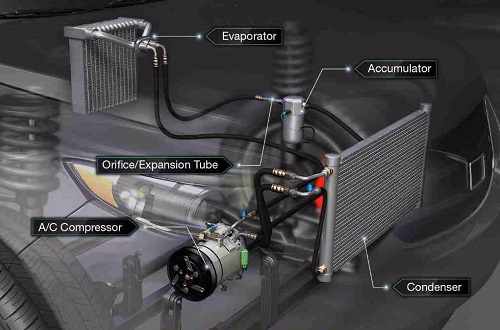
*** If your car or truck engine overheats, take it to a mechanic shop near you for diagnosis right away to avoid major engine damage (extreme overheating can cause complete engine failure, which requires a complete rebuild or replacement to repair).
AC Inspections, AC Recharge, Service & Auto AC Repair
Your vehicle’s air conditioner does more than cool the air in the passenger cabin. It also removes moisture from the air and is necessary to defrost or defog the windows in cold or rainy weather. If the refrigerant is too low or cannot circulate properly, the AC cannot cool and remove moisture from (or condition) the air.
Automotive Air Conditioner Service Recommendations
In many cases, refilling the refrigerant (or having an AC recharge) is only a temporary solution, if it fixes the issue at all. This is why it is necessary to have a thorough air conditioning system inspection (or AC check) to determine WHY the refrigerant is low or cannot circulate through the system adequately. There may be leaks, clogs, broken components, or a loose belt and tensioner, which must be repaired so that the problem does not repeat itself.
Auto AC Repair Diagnostics
Auto Service Experts auto air conditioner diagnostic includes hooking your vehicle up to the latest AC machine and computer scanners. This specialized machine checks high-pressure and low-pressure readings and is used to determine if your car air conditioner is low on Freon. If so, it can recover and add Freon to the correct vehicle manufacturer’s recommended amount.
Our ASE certified HVAC mechanics are also trained & experienced in repairing hybrid car air conditioning systems.
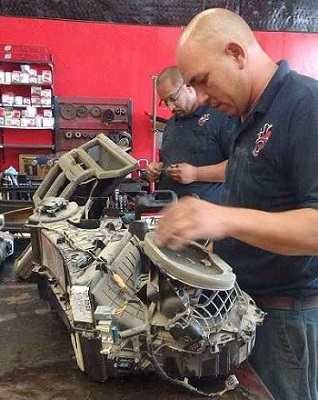
AC Recharge
If your vehicle is low on refrigerant (or Freon), Freon is added through a process known as an AC recharge. An auto air conditioning system is a closed unit and should not lose Freon over time. If Freon levels are low, this indicates a leak somewhere within the system. Leaks can occur within the lines, hoses, connections, or cracks in components such as the compressor, condenser, or evaporator. A recharge may keep your AC blowing cold for a while (depending on the size of the leak), but it does not repair the underlying issue. Because freon is transparent, a dye test is often required to determine where the leak is coming from.
AC Dye Tests
If the vehicle is too low on Freon and the compressor will not turn on, or if the leak is small and impossible to see with the naked eye, you may require a dye test to determine the source of the leak. A dye test involves injecting a fluorescent dye (along with Freon) into the car’s air conditioning system and running it until traces of the dye (visible under UV light) can be seen at the location of the leak. The fluorescent dye helps to point out hard-to-detect leaks because freon is transparent and, therefore, impossible to notice as it escapes the system. Dye tests are performed as a separate service.
Vacuum Test
Refrigerant and air are sucked from the unit with a vacuum pump which creates a vacuum within the system. It is then monitored with a vacuum gauge for some time, possibly overnight, to detect small leaks. If the system does not hold the vacuum, this indicates the presence of an AC leak. The amount of vacuum loss is recorded to determine whether there is a minor or major leak.
AC Electrical Diagnostics
A certified HVAC mechanic will check to ensure there is power from the electrical system (or a pulse with a signal) to the compressor. We check all fuses and relays. If there is an electronic problem beyond the fuses and relays, it may be a computer control problem due to signal loss. Computer control signal loss problems are repaired as a separate service.
*** While we are not known for frigid weather here, it is still essential to have your car heater repaired at the first sign of problems. If your car heater is not working, it could mean that there are problems within the cooling system, which could lead to significant engine damage!
Auto AC Repair Shops Near Me
Many people ask “With all of the local auto AC repair shops, how can I choose the best one to ensure that I am getting the highest level of service, and most value for my money?” There are several ways to quickly research and judge the quality of an auto repair facility in your area before trusting them with your vehicle. Auto Service Experts Blog discusses what to look for and what to ask when searching for a trustworthy and reliable local mechanic shop, as well as many more common automotive repair questions.
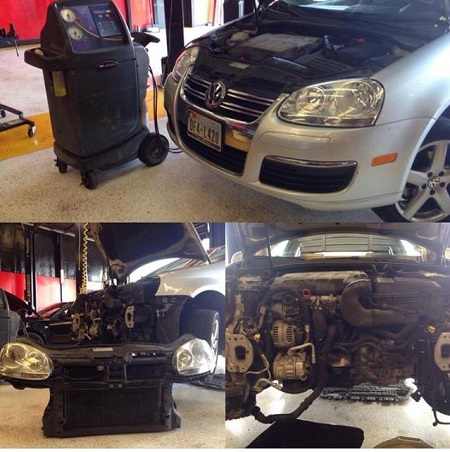
Cabin Air Filter Change or A/C System Cleaning
Your car’s air conditioner is not just responsible for keeping you cool. It also filters and conditions the air you breathe while driving or idling in traffic. The AC system can become clogged when debris and contaminants build up over time. If not properly serviced, bacteria, allergens, mildew, and mold grow inside your vehicle air conditioner, which leads to foul-smelling air coming from the vents and can even make you and your family sick!
Most modern automobiles come equipped with cabin air filters behind the glove box or in the air intake vents in front of the windshield. These filter and clean air as it enters the heating, ventilation, & air conditioning system, known as the HVAC system. They block and trap dust, pollen, pollutants, and other contaminants before they enter the passenger cabin area. Therefore, a dirty cabin air filter can result in the air you breathe inside your vehicle being of poorer quality than the outside air. Cabin air filter replacement is usually recommended every 15,000 miles (or every 5th oil change). Still, it may be necessary more often if driving in heavy traffic congestion or a location with high pollution. If your car or truck does not have a cabin air filter, ask about a cleaning service to eliminate bacteria, mold, and unpleasant smells from within the system.
When Should You Have Your Car Air Conditioner Serviced?
- Yearly, before it gets hot!
- As soon as you notice any decline in AC performance, weak airflow, or warm air.
- If you detect a foul or musty odor from the vents.
AC Service Includes:
- Inspecting lines and hoses for corrosion and leaks.
- Checking high and low pressure readings.
- Testing output air temperature on the coldest setting.
- Changing or cleaning refrigerant.
- Following environmentally safe refrigerant handling and disposal procedures as outlined in the Environmentally Sustainable Actions Certification Program.
Benefits of Service:
- Stay cool and comfortable regardless of Texas weather!
- Reduce repair costs and extend the lifespan of AC components.
- Protect your lungs from mildew, mold, bacteria, allergens, and pollutants.
We back Our Auto Air Conditioning Repairs and Services with the Best Warranty in the Business!
AC Stop Leak Cans Cause Major Damage
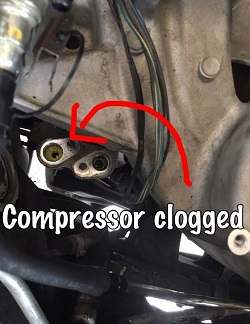
When faced with the need for auto AC repair, it may be tempting to try and fix the problem yourself with a can of stop leak. These are not cheap, quick fixes! They are known in the automotive industry as “suicide cans” because most of them cause severe damage to car air conditioning system components. Repairing this damage (which often requires replacing significant components or the entire system) is much more costly than simply having a leak repaired by a qualified auto AC mechanic.
Auto Air Conditioner Performance Tips
- During AC service, special oils are inserted into the system along with the refrigerant. The AC should be turned on periodically, even during cold weather. This allows these oils to circulate through the system and provide lubrication & protection for AC components, seals, and gaskets.
- If your auto A/C produces a foul-smelling odor, using the outside air mode rather than the recycled air mode will help reduce the odor and provide fresher air. Your vehicle may need a cabin air filter change, or A/C system cleaning service.
- Even if your A/C is blowing cold air, a clogged cabin air filter blocks most of that air from reaching you. Restricted cabin air filters cause the system to work much harder while providing little relief from the heat!
- Car air conditioning systems require a lot of horsepower to operate (usually 15% – 20%), reducing fuel economy quite a bit.
- Operating your car A/C system generates a lot of heat in the engine and strain on the vehicle’s cooling system. A well-maintained cooling system will be better able to handle this extra workload and prevent the engine from overheating, which can result in costly repairs.
- If your car is in a secure location, leave the windows cracked while parked. This will keep the interior temperature from rising as high, allowing your A/C to cool down the cabin more quickly.
- When you start your car, turn the A/C on to the coldest setting. Use maximum blowing speed, and roll all windows down completely. This will force hot air out of the vehicle and generate circulation, speeding up the cooling process.
- Turning on the air recirculation mode once the cabin air temperature is sufficiently cool allows the air conditioning system to operate more efficiently.
- With automatic temperature control AC systems, the cabin air will reach your desired temperature faster if you set it at the coldest setting first, then readjust to the desired temperature as needed.
- Once the car is sufficiently cooled, use lower blower speeds. This allows the A/C system to generate colder air.
Air Conditioning System Operation
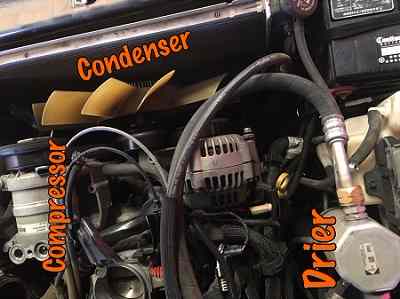
Refrigerant / Freon
AC refrigerant is a chemical compound that absorbs and transfers heat in a refrigerant cycle. It is commonly referred to as Freon, which is a trademark name. An automotive air conditioner incorporates several components that work together to circulate, compress, cool, and condense refrigerant. Refrigerant is changed from a gas or vapor state into a liquid state, then back into gas in a continuous cycle. R-12 refrigerant was used in most vehicles until it was banned in 1994 and replaced by the more environmentally friendly R-134a refrigerant. Today’s automobile manufacturers (including GM) are beginning to use HFO class refrigerants such as R-1234y & R-744 which offer increased energy efficiency. They are more cost effective and have less of a harmful effect on the ozone layer, therefore contribute less to global warming. An AC recharge should only be performed by a professional technician using specialized equipment that recovers & recycles refrigerant, minimizing environmental damage.
Compressor
The AC compressor is sometimes referred to as the heart of a car’s air conditioning system because it supplies the system with Freon, or the blood. Freon is a liquid refrigerant that is pumped into the compressor in gas form through the suction port. This gas is then pressurized within the discharge port. The compressed Freon is circulated through a series of different-sized cylinders and hoses, which create alternating vacuum and pressure, and an expansion valve designed to make the gas contract and expand. Some compressors have a rotary/vane design, and others use pistons and rods to connect to the main shaft. Compressors receive power from a drive belt in the engine. Controls moderate pressure and cabin temperature inside the compressor, and refrigeration can be turned on or off by an engagement clutch which is electrically controlled.
Condenser
From the compressor, the gaseous Freon is pumped into the AC condenser. The condenser uses the engine fan’s cold air to reduce the temperature of the gas and turn it back into liquid. This liquid flows through a filter which collects all foreign contaminants, into receiver-driers (Expansion Valve System), or accumulators (Orifice Tube System), where it is stored.
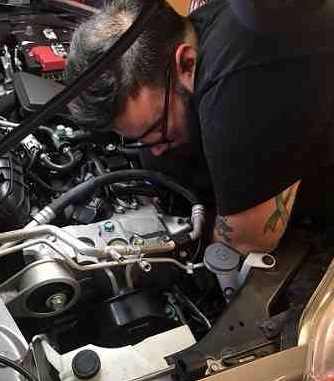
Nissan Repair at Auto Service Experts – Auto AC Compressor Kit Replacement on Nissan Rouge
Orifice Tube System / Accumulator
The AC orifice tube system is designed to keep Freon from flooding the evaporator or entering the compressor in liquid form. These systems control the Freon flow from the accumulators to the evaporator. AC accumulators trap moisture within the system, and clean and store refrigerant. The orifice tube changes Freon from high-pressure liquid into low-pressure liquid and supplies only a mist of Freon to be evaporated back into gas. The orifice tube system is found in most domestic cars, trucks, and SUVs.
Expansion Valve System / Receiver-Drier
Most foreign or import vehicles are equipped with an AC expansion valve system which takes the place of the orifice tube system. The systems use receiver driers instead of accumulators, which are very similar in operation and function, with the major difference being where they are located within the air conditioning system. A receiver-drier is connected on the high-pressure side, and an accumulator is on the low-pressure side.
Evaporator
Compressed refrigerant is transferred from the condenser to the AC evaporator. Excess condensation is allowed to escape the evaporator through a drain tube. This condensation can be seen dripping beneath the vehicle and may leave a substantial puddle. This is normal, although it is sometimes mistaken for an AC Leak. From the evaporator, the gaseous freon returns to the suction port of the compressor to repeat the process.
Air Conditioner Components That Periodically Need Service
Common Car Air Conditioner Problems often involve repairs or replacements of one or more of the following components:
- Compressor
- Condenser
- Liquid Line
- Orifice Tube
- Receiver/Drier
- Accumulator
- Control Head
- Low Pressure Switch
- Amplifier
- Ambient Temperature Sensor
- Dual Climate Control
- Evaporator
- Cabin Filters
- High-Pressure Switch
- Vintage Air
- Manifold Hoses
- Blend Door Actuators
- Evaporator Cases
- R-12
- 134-A
- Retrofit
- High and Low Fittings
- Blower Motors
- Relay
